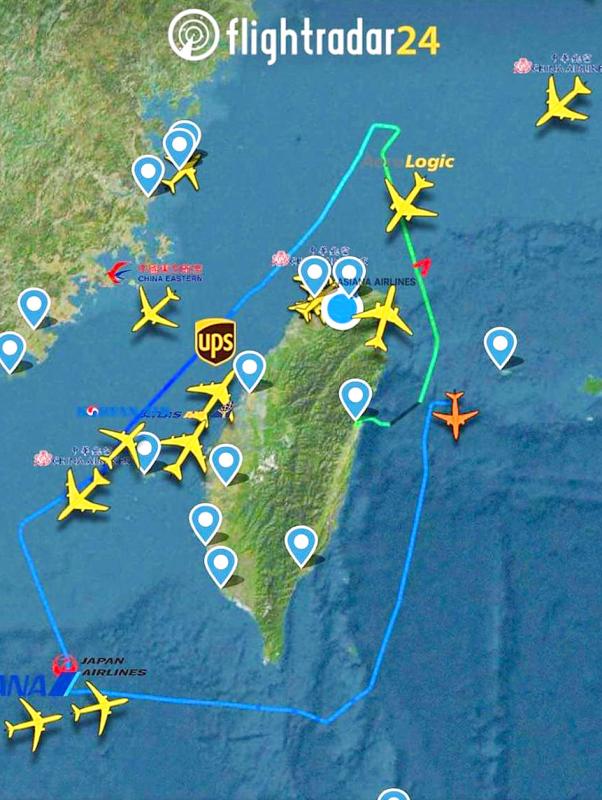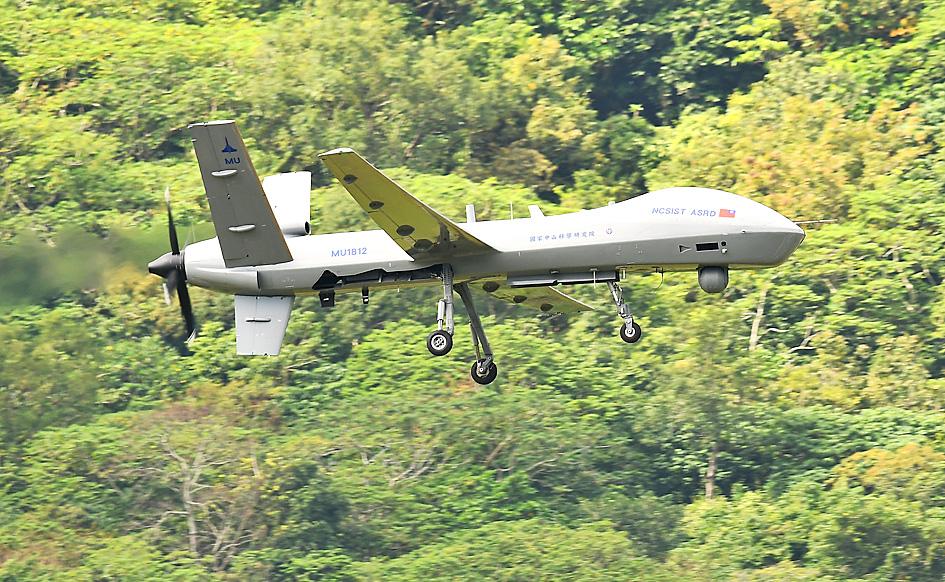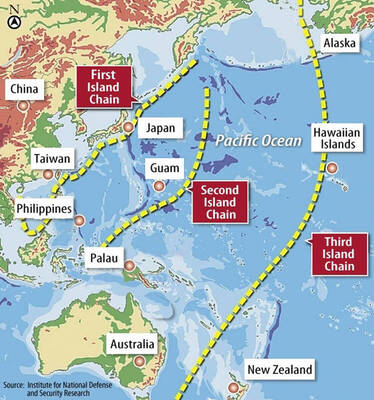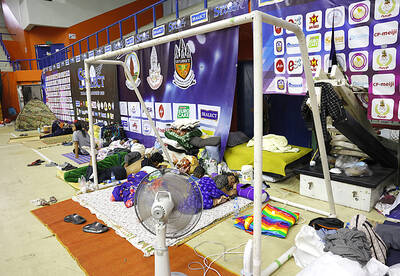The domestically designed Teng Yun 2 drone passed development milestones over the weekend, flying for more than 10 hours straight and circling Taiwan’s air defense identification zone (ADIZ), in the longest flight of an indigenous uncrewed combat aerial vehicle.
Developed by the Chungshan Institute of Science and Technology, the Teng Yun 2, or “Cloud Rider” (騰雲二型), recorded its longest flight yet over the weekend, after a three-hour test flight last month, followed by five and seven-hour stretches in the air.
The Teng Yun 2 No. 1812 departed from Chiashan Air Base in Hualien County at 6:46pm on Saturday and flew on a counter-clockwise route along the edge of the ADIZ, circling Taiwan proper, the institute said.

Screen grab from Flightradar24.com
At 5:02am the following morning, the drone landed safely at the base, after a flight time of 10 hours and 16 minutes, it said.
The Teng Yun 2 was designed to complement the military’s four US-made strategic drones, and has capabilities including day and night aerial image surveillance and reconnaissance, electronic parameter reconnaissance, electronic interference, meteorological observation and signal relay, it said.
The institute would complete testing of the drone by the end of the year, a source said yesterday, adding that it would start mass production if tests go smoothly.

Photo: Yu Tai-lang, Taipei Times
Defence International Magazine editor Chen Kuo-ming (陳國銘) praised the test results, but expressed concerns over lengthy procurement times for the drone’s engine, which is manufactured by the US.
Chen said that the military should seek backup suppliers in the EU to prevent a potential production bottleneck.
The issue might have been discussed at the Monterey Talks, which focused on Taiwan’s asymmetric combat capabilities, he said.
Meanwhile, Taiwan is expected to accept delivery of US-made MQ-9 Reaper drones later this year that the US in 2020 agreed to sell.
Lee Shih-chiang (李世強), head of the Ministry of National Defense’s Department of Strategic Planning, said during a question-and-answer session at the legislature in March last year that the Reaper would fit well with the military’s needs.
The Reaper is a high-altitude drone, whereas the Teng Yun 2 is a low to medium-altitude drone, he said.

The US government has signed defense cooperation agreements with Japan and the Philippines to boost the deterrence capabilities of countries in the first island chain, a report by the National Security Bureau (NSB) showed. The main countries on the first island chain include the two nations and Taiwan. The bureau is to present the report at a meeting of the legislature’s Foreign Affairs and National Defense Committee tomorrow. The US military has deployed Typhon missile systems to Japan’s Yamaguchi Prefecture and Zambales province in the Philippines during their joint military exercises. It has also installed NMESIS anti-ship systems in Japan’s Okinawa

‘WIN-WIN’: The Philippines, and central and eastern European countries are important potential drone cooperation partners, Minister of Foreign Affairs Lin Chia-lung said Minister of Foreign Affairs Lin Chia-lung (林佳龍) in an interview published yesterday confirmed that there are joint ventures between Taiwan and Poland in the drone industry. Lin made the remark in an exclusive interview with the Chinese-language Liberty Times (the Taipei Times’ sister paper). The government-backed Taiwan Excellence Drone International Business Opportunities Alliance and the Polish Chamber of Unmanned Systems on Wednesday last week signed a memorandum of understanding in Poland to develop a “non-China” supply chain for drones and work together on key technologies. Asked if Taiwan prioritized Poland among central and eastern European countries in drone collaboration, Lin

Renewed border fighting between Thailand and Cambodia showed no signs of abating yesterday, leaving hundreds of thousands of displaced people in both countries living in strained conditions as more flooded into temporary shelters. Reporters on the Thai side of the border heard sounds of outgoing, indirect fire yesterday. About 400,000 people have been evacuated from affected areas in Thailand and about 700 schools closed while fighting was ongoing in four border provinces, said Thai Rear Admiral Surasant Kongsiri, a spokesman for the military. Cambodia evacuated more than 127,000 villagers and closed hundreds of schools, the Thai Ministry of Defense said. Thailand’s military announced that

NO CONFIDENCE MOTION? The premier said that being toppled by the legislature for defending the Constitution would be a democratic badge of honor for him Premier Cho Jung-tai (卓榮泰) yesterday announced that the Cabinet would not countersign the amendments to the local revenue-sharing law passed by the Legislative Yuan last month. Cho said the decision not to countersign the amendments to the Act Governing the Allocation of Government Revenues and Expenditures (財政收支劃分法) was made in accordance with the Constitution. “The decision aims to safeguard our Constitution,” he said. The Constitution stipulates the president shall, in accordance with law, promulgate laws and issue mandates with the countersignature of the head of the Executive Yuan, or with the countersignatures of both the head of the Executive Yuan and ministers or